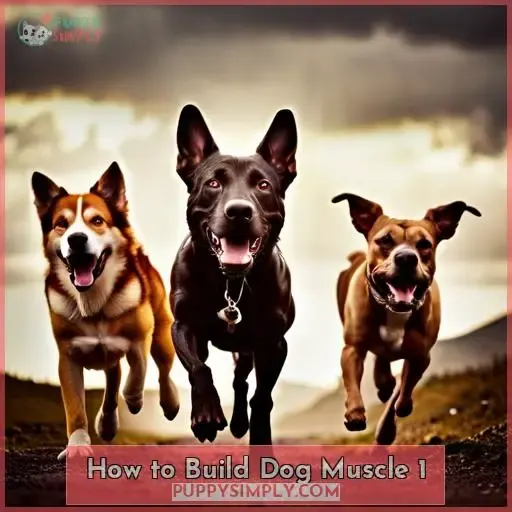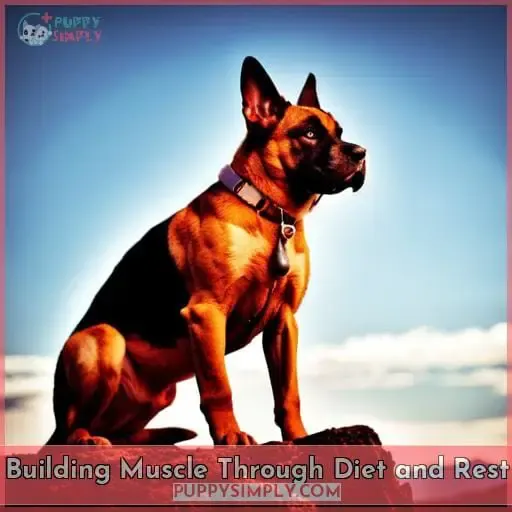This site is supported by our readers. We may earn a commission, at no cost to you, if you purchase through links.

Building muscle in dogs involves three distinct steps and requires an understanding of the best exercises and tips to get results. We’ll cover everything from choosing the right activities, strengthening senior dogs, assessing condition through diet and rest – even breeds that naturally build muscle! Let’s explore how we can beef up our furry friends safely and effectively.
Table Of Contents
Key Takeaways
- Nutritious diet, resistance exercise, and rest are the three key steps for building dog muscle.
- Assessing a dog’s health, weight, and body condition is important before starting a muscle-building program.
- Muscle loss in aging or sedentary dogs can be improved through targeted exercises and diet changes.
- It is important to consult a vet before starting puppy muscle building to ensure it is safe and appropriate for their age and breed.
Three Steps for Building Dog Muscle
You can help your pup bulk up by providing a nutritious diet, exercising with resistance to strain their muscles, and ensuring they get plenty of rest for repair – all in moderation, as the saying goes.
First, assess your dog’s health: check his diet, weight, and body condition. Muscle loss is common among aging or sedentary dogs, so it’s important to have an appropriate muscle-building routine that improves muscle condition over time.
If you need some extra help getting started on the right track with building those muscles, then there are healthy weight supplements available which will aid in gaining back any lost mass after injury or illness.
This also applies to strengthening senior dogs who may be suffering from deteriorating strength due to age-related factors such as arthritis, etc.
Resistance training can be great too if you have a working breed since it helps build endurance, making them better suited for tasks requiring stamina and agility.
Certain breeds like Boxers or Bulldogs tend to build more quickly than others, so make sure not to overlook these differences when considering adding exercise routines into their daily lives. Vet assessments, including score charts, are invaluable tools for determining how much progress has been made thus far in improving their overall fitness levels (the difference between fat vs muscular body composition).
It is essential, however, that we find a balance between diet, exercise, and rest. Start slowly, progressing gradually while keeping safety a top priority throughout.
Protein-rich diets combined with good warm-ups and cool-downs, along with activities like treadmill runs wearing weighted vests, swimming, dragging heavy objects across uneven terrain, and spring pole work, would all significantly improve overall performance results while helping prevent atrophy during periods of extended recovery times.
Making sure our furry friends get enough sleep/rest each night allows them ample opportunity to recover properly, allowing us to ensure long-term benefits from this special investment we make towards maintaining excellent physical health now and well into old age!
Starting Slowly and Progressing Gradually
Begin your journey slowly and progress gradually, allowing your pup to naturally adjust as needed. Muscle development is an ongoing process that should be done with patience and care. Start by assessing the current state of their diet, weight, body condition, and muscle condition – this will provide you with a baseline for future improvement.
If any deficiencies or imbalances are found in these areas, then dietary supplements may be necessary to get back on track towards achieving optimal health!
Next up: resistance training! This type of exercise helps build strength in working breeds like retrievers or shepherds, but it’s important not to overdo it when introducing puppy muscles into the mix since they are still growing rapidly at this stage too! Consult with your vet about potential score charts, which can assess how well each variety of activity is going for them before moving onto more intense regimens down the line if desired.
Also, remember that rest & sleep play a crucial role in keeping those muscles healthy – don’t forget about them during periods where physical activity might take priority every once in a while as part of an overall balanced routine between nutrition/exercise/restorative measures (just like us humans!).
Protein-rich diets help support growth while warm-ups/cool downs prevent injury; both should work together synergistically alongside other activities such as treadmill runs wearing weighted vests plus swimming + dragging heavy objects across uneven terrain + spring pole work, etc.
All designed specifically tailored based on individual size & breed needs ultimately leading towards better performance results without putting stress on developing bones & joints unnecessarily either way though.
To ensure successful outcomes from bulking up our furry friends requires consistency along with proper monitoring, so never hesitate to seek out professional advice whenever possible — especially if signs appear indicating fatigue or injury has occurred somewhere along the course unexpectedly (and stop immediately).
Choosing the Right Exercises
You can help your dog build muscle by choosing the right exercises. Weight vest activities, weight dragging or pulling, swimming, spring pole work, and treadmill time are all good options to consider. It is important to choose exercises that fit your pup’s size and breed as well as start gradually and progress slowly to ensure their safety while bulking up their muscles.
Weight Vest Activities
Walking your pup with a weighted vest is an excellent way to help him build muscle strength. It combines agility training and canine nutrition for the best results, improving stamina while avoiding fatigue.
But breed differences should be taken into consideration as well; start slowly and progress gradually according to your dog’s needs.
Weight Dragging or Pulling
Try incorporating weight dragging or pulling into your pup’s workout routine for an extra challenge! This helps prevent muscle loss and atrophy in adult dogs, while satisfying the dietary needs of puppies.
Additionally, it can be a great way to build up their strength and endurance. Vet assessments should always be taken into consideration when adding this exercise into your dog’s routine; do not exceed the natural form of the breed.
Swimming
Swimming is an effective way to help your pup strengthen their muscles and build endurance. Low-impact resistance training makes it ideal for senior dogs, while still providing the necessary exercise they need.
Track fitness progress with suitable water safety measures in place and consider breed differences when setting goals.
Spring Pole Work
Spring pole work is an excellent way to strengthen your pup’s muscles and help them build endurance. Getting started requires the right setup. Muscle types that are best suited for this activity and safety considerations for puppies should also be taken into account.
The spring pole provides low impact resistance training, which helps condition different muscles without compromising puppy safety or pushing too hard. Protein sources should also be included in regular meals to fuel growth and repair after exercise sessions.
Treadmill Time
Treadmill time is an effective way to bulk up your pup’s muscles and help them gain strength quickly. Research shows that just ten minutes on a treadmill doubles the intensity of traditional walking, yielding powerful results! Weight lifting, muscle gain, nutrition tips, and vet advice should all be included in any exercise plan for maximum success.
Consider incorporating weight vests or pulling activities to focus efforts on specific muscles, but always ensure progress remains gradual with plenty of rest days sprinkled in.
Strengthening Senior Dogs
As you may be aware, muscle loss in senior dogs can lead to weakness and reduced mobility. Therefore, helping them regain or maintain their muscle is essential for overall health and well-being. For this purpose, a balanced routine comprising of dieting, exercising regularly, as well as restful sleep, is all important components of building dog muscles after injury or illness.
Not only does it help enhance the performance of working dogs, but it also helps improve the condition of aging ones.
Regaining Muscle After Injury, Surgery, or Illness
If your pup has suffered an injury, surgery, or illness that caused muscle atrophy, regaining strength and mobility can be achieved through a balanced routine of diet, exercise, and rest. Start by consulting with a veterinarian to assess the dog’s health, including diet, weight, body condition, and muscle condition.
Afterward, create an exercise safety plan tailored to the needs of your pup. This can include resistance training activities like weight vests or treadmill time. Additionally, a protein-rich diet supplemented with healthy weight gain products may help in rebuilding muscles lost during recovery from surgery or long-term illnesses like cancer.
Puppies should not engage in any type of bulking up regimen, as this can impede their overall development. Instead, focus on strengthening senior dogs for improved health and reduced musculature loss over time.
It is important to monitor vet score charts that measure progress against fat composition standards for each breed type.
With consistency, you’ll have your beloved pooch back on four paws again before you know it!
Enhancing Work Dogs’ Performance
For work dogs, resistance training activities such as weight vest and dragging exercises can help boost their performance like a rocket. These activities improve strength and agility while combating muscle atrophy caused by injury or illness.
A balanced routine of diet, exercise, and rest is essential for building dog muscles. Opt for protein-rich foods to aid in the process. Healthy weight gain supplements may also be beneficial if your pup needs to bulk up quickly after an accident or surgery.
Consider adding treadmill time into the mix too – it’s great for strengthening a senior dog’s core muscles! But make sure you supervise your pup closely when they’re on the treadmill – safety first!
Remember that regaining lost muscle mass takes patience and dedication. Don’t give up if progress isn’t immediate! With consistency of care tailored specifically to your working pooch’s needs, you’ll have them back at peak performance in no time flat.
Breeds That Naturally Build Muscle
Certain breeds of dogs are naturally predisposed to building muscle, and you can help them along the way with a balanced routine. When selecting a breed for bulking up your dog, it’s important to assess its health first.
An ideal body condition score and muscle assessment will give you an indication as to whether or not they have what it takes for serious resistance training.
Feeding your pup a high-protein diet can also contribute significantly towards their goal of gaining mass. Puppy muscle-building should be discouraged, though, because this could hinder overall development in some cases.
In senior dogs, strengthening their muscles helps reduce the risk of atrophy due to age or illness-related issues such as surgery or injury recovery processes where mobility may become affected over time without proper care taken into consideration when trying to build strength again in the animal’s body frame.
However, certain breeds like Pit Bulls tend to be able to reach peak physical performance more quickly than others. So, if that is desired, then one might consider looking into those specific kinds while looking at potential pet options before making any final decisions on which type would best fit certain needs/requirements that a person may have upon getting themselves an animal companion from within particular species groupings found out there nowadays.
Overall, though, regardless of whatever kind of canine ends up chosen by an individual, regular vet checkups combined with good amounts of exercise are needed in order to keep metabolism going strong enough to make sure everything stays healthy at all times.
This goes a long way in ensuring that a four-legged friend gets the most out of his/her life possible throughout the years spent together, both owner and master alike.
Assessing Your Dog’s Muscle Condition
To properly assess your pet’s muscle condition, it’s important to take into account their diet, weight, and body composition. Muscle atrophy can be a side effect of injury or illness, and proper exercise and nutrition are essential for recovery.
A vet assessment will help determine the current state of a dog’s muscles as well as give you an idea of how to improve them.
A balanced routine that includes both adequate rest/sleep and plenty of activity throughout the day is key in building muscle mass safely over time without causing any damage or undue strain on joints, bones, etc.
Additionally, providing pets with high-protein diets, including supplements, can also aid in helping them gain weight after illness or surgery has taken place.
It’s especially important to differentiate between fat deposits versus actual muscular growth when assessing canine bodies since this could result in different outcomes depending on what one wants from his/her pet ultimately speaking further down the line where results become either more obvious than before initially assumed previously by the owner themselves (if applicable).
Finally, regular vet checkups combined with score charts will make sure everything stays healthy while bulking up efficiently within certain limits set forth depending upon the particular breed chosen, which may build muscle faster than others naturally do compared against other types found across various species groupings these days too.
Building Muscle Through Diet and Rest
You can help your pup bulk up in no time by providing a balanced routine of diet, exercise, and rest – just like you would for yourself! A healthy weight dog supplement may be beneficial to gain the desired muscle mass.
This will ensure that their dietary needs are met while also helping them heal after an injury or illness.
To assess whether they need such additional support, consult with a veterinarian on how best to proceed and then follow their advice accordingly. It is also important to differentiate between fat deposits versus actual muscular growth when assessing canine bodies since this could result in different outcomes depending on what one wants from his/her pet ultimately speaking further down the line where results become more obvious than before initially assumed previously by the owner themselves (if applicable).
A vet assessment combined with score charts will make sure everything stays healthy while bulking up efficiently within certain limits set forth depending upon the particular breed chosen which may build muscle faster than others do compared against other types found across various species groupings these days too.
Furthermore, proper nutrition is essential for building strong muscles, so provide high-protein diets supplemented as needed along with resistance training exercises tailored specifically towards working dogs’ performance capabilities all around here today still yet once again right now too at least!
Finally, don’t forget about rest periods either because those times are necessary for proper recovery processes involved therein each case scenario presented here today overall speaking even moreso as well not surprisingly enough really quite honestly though finally altogether still yet nonetheless somehow someway someday soon afterwards maybe hopefully possibly eventually perhaps potentially likely probably possibly surely sometimes most definitely anyway.
| Dietary Supplements | Fat Composition | Vet Assessment |
|---|---|---|
| Provide extra nourishment if needed | Differentiate between fat deposits & muscle growth | Regularly checkups + score chart monitoring |
| Muscle Atrophy | ||
| :————–: | :–: | |
Frequently Asked Questions (FAQs)
Are there any risks associated with muscle building in dogs?
Yes, there can be risks associated with muscle building in dogs. If done incorrectly, it may cause injury or strain on the dog’s body. It is important to consult a vet and follow their instructions to ensure your pet stays healthy while gaining muscle.
What type of supplements should I give my dog to help with muscle building?
Consult your veterinarian to determine the best supplements for your dog’s muscle-building needs. They can help you choose a protein-rich diet and nutritional supplements that will give them the energy they need to build strong muscles.
How long should a dog’s exercise routine be?
Exercising your pup’s muscles should be done for about 10-20 minutes per day, but this may vary depending on their breed and size. Begin with shorter periods and gradually increase to prevent injury or exhaustion, as these could hinder muscle growth.
How quickly can I expect to see results from muscle building?
With a healthy diet, exercise routine, and rest, you should see quick results in your dog’s muscle building.
What should I do if my dog is not interested in exercise?
If your dog isn’t keen on exercise, try making it fun! Incorporate treats, games, and rewards to encourage activity. Offer variety in the form of different activities; you could also enlist a friend with their own pup for playdates.
Conclusion
Gaining muscle is a great way to help your dog stay healthy and active. With the right combination of exercise, rest, and a nutritious diet, you can help your dog build muscle. Start off slow and progress gradually, and remember to consult your vet regularly.
Focus on exercises that help your pup build strength and muscle mass, while also avoiding over-exertion. With patience and dedication, your pup will soon be sporting their very own chiseled physique, ready to take on any adventure that comes their way.
So, grab your pup’s leash and get ready for a journey; your pup will thank you for it.













